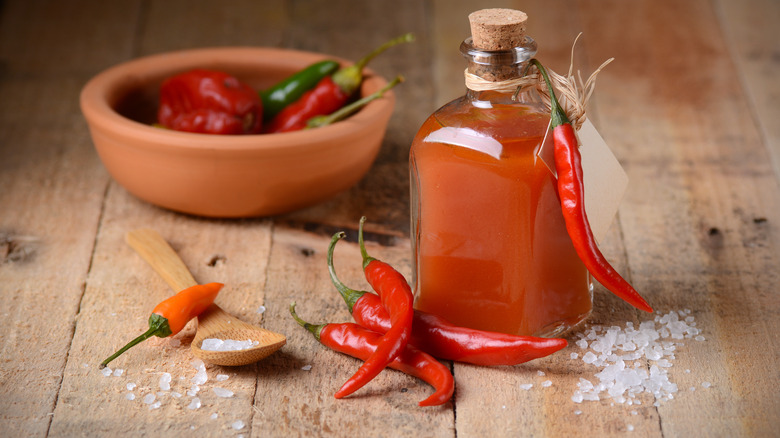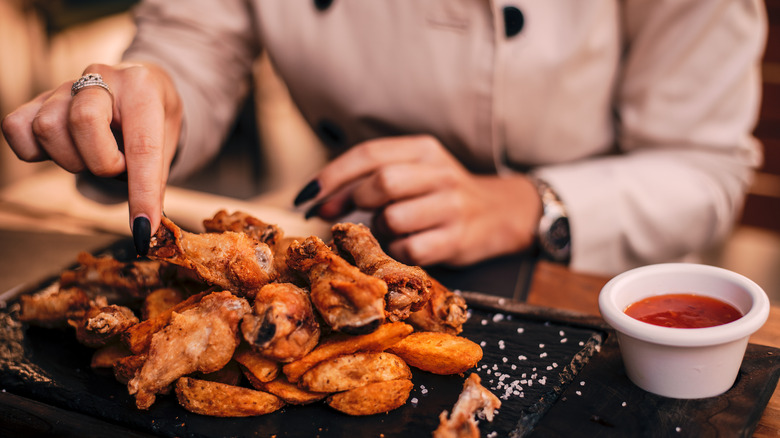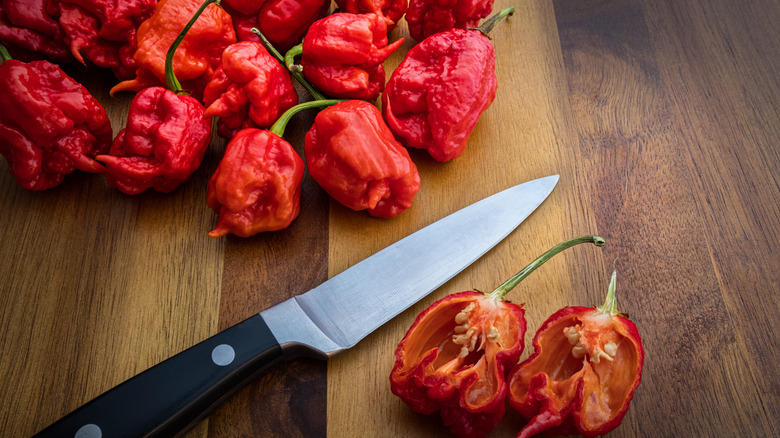The Science Behind Why Hot Sauce Can Make Us Feel Happy
If you're a huge fan of hot sauce and other spicy foods, your body may be hooked on the good feelings they afford. According to Mother Jones, the chili peppers that make up your favorite hot sauce contain capsaicin, a substance that causes minor amounts of pain when consumed. Upon sensing this pain, the body releases endorphins, which are feel-good chemicals that reduce pain levels. Endorphins also contribute to an overall sense of well-being, and they also decrease stress. As a result, you may feel compelled to indulge in hot sauce again and again to recreate these good feelings.
So, why do chili peppers contain capsaicin in the first place? It's believed that capsaicin gave peppers an evolutionary advantage, as it could prevent mammals from eating them and digesting their precious seeds. Birds do not experience the same painful sensation when eating peppers and are integral in spreading pepper seeds around so more plants can grow. However, another theory suggests that capsaicin in peppers is meant as a deterrent to insects, which can leave small bite marks in peppers, in turn encouraging fungal growth. Regardless of the specific reason, it appears that certain adventurous human mammals enjoy the sensation afforded by spicy food.
A love of spicy foods could mean that you're a risk-taker
While some people would never torture themselves with the hottest of hot sauces, others can't get enough of the stuff. As explained by NBC News, research shows that people prone to indulging in risk-taking behaviors are far more likely to seek out spicy food experiences. While further study is needed to determine the exact correlation, some suggest the impulse could have something to do with a person's adrenaline levels.
According to researcher Dr. Alan Hirsch, it's believed that people who are attracted to risky behaviors, which can include things like gambling, extreme sports, or watching scary movies, may be lacking in adrenaline as compared to other individuals. As a result, people may partake in risky behaviors to boost adrenaline levels. Eating hot sauce and other foods containing capsaicin also causes an adrenaline spike, albeit in a very controlled and usually harmless way. Despite the many benefits of hot sauce, too much can be a bad thing. That's why all risk-taking spice lovers should acquaint themselves with the helpful Scoville scale.
How to make sure that your hot sauce isn't too hot
The Scoville scale was developed by Wilbur Scoville in 1912. It's used to measure the spiciness of different peppers, which is expressed in Scoville Heat Units (SHU). Understanding the Scoville scale allows you to buy hot sauce with confidence, as you can rest assured that you won't select a bottle too intense for your taste buds.
At the very top of the scale is pure capsaicin, which ranks at a staggering 16,000,000 SHU. Pure capsaicin is typically provided as an extract, which is sparingly added to recipes to turn up the heat. Next in line is the Carolina Reaper pepper, which contains 2,200,000 SHU and has the proud designation of being the world's hottest pepper. Much less intense but still packing quite a kick is the habanero pepper, which offers 350,000 SHU. Jalapeños are a great starter pepper with just 10,000 SHU, making them acceptable to most palates. The bell pepper, by contrast, contains 0 SHU. The next time you're shopping for a new hot sauce brand, be sure to check out the SHU on the bottle to know exactly what you're getting into.


